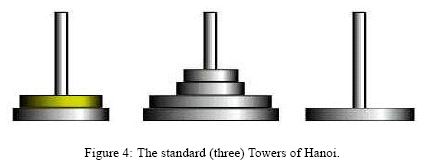 |
| ||||
Home Page
F.A.Qs
Statistical Charts
Past Contests
Scheduled Contests
Award Contest
| ||||||||||
| Online Judge | Problem Set | Authors | Online Contests | User | ||||||
|---|---|---|---|---|---|---|---|---|---|---|
| Web Board Home Page F.A.Qs Statistical Charts | Current Contest Past Contests Scheduled Contests Award Contest | |||||||||
|
Language: Strange Towers of Hanoi
Description Background
Charlie Darkbrown sits in another one of those boring Computer Science lessons: At the moment the teacher just explains the standard Tower of Hanoi problem, which bores Charlie to death!  The teacher points to the blackboard (Fig. 4) and says: "So here is the problem:
So your task is to write a program that calculates the smallest number of disk moves necessary to move all the disks from tower A to C." Charlie: "This is incredibly boring—everybody knows that this can be solved using a simple recursion.I deny to code something as simple as this!" The teacher sighs: "Well, Charlie, let's think about something for you to do: For you there is a fourth tower D. Calculate the smallest number of disk moves to move all the disks from tower A to tower D using all four towers." Charlie looks irritated: "Urgh. . . Well, I don't know an optimal algorithm for four towers. . . " Problem So the real problem is that problem solving does not belong to the things Charlie is good at. Actually, the only thing Charlie is really good at is "sitting next to someone who can do the job". And now guess what — exactly! It is you who is sitting next to Charlie, and he is already glaring at you. Luckily, you know that the following algorithm works for n <= 12: At first k >= 1 disks on tower A are fixed and the remaining n-k disks are moved from tower A to tower B using the algorithm for four towers.Then the remaining k disks from tower A are moved to tower D using the algorithm for three towers. At last the n - k disks from tower B are moved to tower D again using the algorithm for four towers (and thereby not moving any of the k disks already on tower D). Do this for all k 2 ∈{1, .... , n} and find the k with the minimal number of moves. So for n = 3 and k = 2 you would first move 1 (3-2) disk from tower A to tower B using the algorithm for four towers (one move). Then you would move the remaining two disks from tower A to tower D using the algorithm for three towers (three moves). And the last step would be to move the disk from tower B to tower D using again the algorithm for four towers (another move). Thus the solution for n = 3 and k = 2 is 5 moves. To be sure that this really is the best solution for n = 3 you need to check the other possible values 1 and 3 for k. (But, by the way, 5 is optimal. . . ) Input There is no input. Output For each n (1 <= n <= 12) print a single line containing the minimum number of moves to solve the problem for four towers and n disks. Sample Input No input. Sample Output REFER TO OUTPUT. Source TUD Programming Contest 2002, Darmstadt, Germany |
[Submit] [Go Back] [Status] [Discuss]
All Rights Reserved 2003-2013 Ying Fuchen,Xu Pengcheng,Xie Di
Any problem, Please Contact Administrator